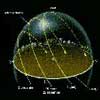 Splošni kalkulator lege Sonca in energije
Splošni kalkulator lege Sonca in energije
Formule so dokaj nenantančne (Low Accuracy Equations),
vzhod in zahod sta natančna na 2 minuti, pozicija na stopinjo.
Pomen kalkulatorja je njegova enostavnost v aplikacijah, ki
ne zahtevajo večje natančnosti (recimo krmiljenje sončnih celic,
računanje energije Sonca, itn). Dodal sem še enačbo za energijo Sonca!
Delno povzeto po:
http://www.srrb.noaa.gov/highlights/sunrise/calcdetails.html
- noaa enačbe (spodaj - Low Accuracy Equations) dajo čase vzhodov
in zahodov vsaj dve minuti natančno.
Pomen kalkulatorja je njegova enostavnost v aplikacijah, ki
ne zahtevajo večje natančnosti (recimo krmiljenje sončnih celic,
računanje energije Sonca, itn).
Dodal sem še enačbo za energijo Sonca!
Natančni kalkulator vzhoda in zahoda Sonca je recimo na NOAA:
http://www.esrl.noaa.gov/gmd/grad/solcalc/
Priredil: Zorko Vičar
November 2010


General Solar Position Calculations (Low Accuracy Equations)
First, the fractional year y is calculated, in radians.
y = (2*Pi/365)*(day_of year - 1 + (hour-12)/24)
From y, we can estimate the equation of time (in minutes) and the solar
declination angle (in radians).
eqtime = 229.18*(0.000075+0.001868*cos(y)-0.032077*sin(y)-0.014615*cos
(2*y)-0.040849*sin(2*y)
declin = 0.006918-0.399912*cos(y)+0.070257*sin(y)-0.006758*cos(2*y)+
0.000907*sin(2*y)-0.002697*cos(3*y)+0.00148*sin(3*y)
Next, the true solar time is calculated in the following two equations.
First the time offset is found, in minutes, and then the true solar time,
in minutes.
time_offset = eqtime - 4*longitude + 60*offset
where eqtime is in minutes, longitude is in degrees, timezone is in hours
from UTC (Mountain Standard Time = +7 hours).
tst = hours*60 + minutes + time_offset
where hr is the hour (0-23), mn is the minute (0-60), sc is the second (0-60).
The solar hour angle, in degrees, is:
ha = tst/4 - 180
The solar zenith angle (Phi) can then be found from the following equation:
cos(Phi )= sin(lat)*Math.sin(declin)+cos(lat)*cos(declin)*cos(ha)
And the solar azimuth (Theta, clockwise from north) is:
cos(180-Theta) = -(sin(lat)*cos(Phi)-sin(declin))/(cos(lat)*sin(Phi))
----------------------------------------------------------------------
Sunrise/Sunset Calculations
For the special case of sunrise or sunset, the zenith is set to 90.833° (the
approximate correction for atmospheric refraction at sunrise and sunset), and
the hour angle becomes:
ha = +/- arccos (cos(90.833/(cos(lat)*cos(declin))-tan(lat)*tan(declin))
where the positive number corresponds to sunrise, negative to sunset.
Then the UTC time of sunrise (or sunset) in minutes is:
sunrise = 720 + 4*(longitude-ha)-eqtime
where longitude and hour angle are in degrees and the equation of time is in minutes.
Solar noon for a given location is found from the longitude (in degrees) and the equation
of time (in minutes):
snoon = 720 + 4*longitude - eqtime
 Splošni kalkulator lege Sonca in energije
Splošni kalkulator lege Sonca in energije
 Splošni kalkulator lege Sonca in energije
Splošni kalkulator lege Sonca in energije

